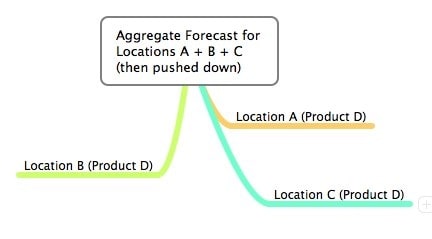Understanding Bill of Distribution Forecasting in SAP SPP
Executive Summary
- In forecasting, the forecast is performed across the bill of distribution.
- How flexible forecasting systems work versus SPP.

Pre Reading
To understand this article, it is crucial to comprehend attribute-based forecasting, which is covered in this article.
Our References for This Article
If you want to see our references for this article and other related Brightwork articles, see this link.
Notice of Lack of Financial Bias: We have no financial ties to SAP or any other entity mentioned in this article.
- This is published by a research entity, not some lowbrow entity that is part of the SAP ecosystem.
- Second, no one paid for this article to be written, and it is not pretending to inform you while being rigged to sell you software or consulting services. Unlike nearly every other article you will find from Google on this topic, it has had no input from any company's marketing or sales department. As you are reading this article, consider how rare this is. The vast majority of information on the Internet on SAP is provided by SAP, which is filled with false claims and sleazy consulting companies and SAP consultants who will tell any lie for personal benefit. Furthermore, SAP pays off all IT analysts -- who have the same concern for accuracy as SAP. Not one of these entities will disclose their pro-SAP financial bias to their readers.
Introduction
Previously I wrote how much I liked the ability to forecast based upon flexible attributes in the application Demand Works Smoothie. I was recently at ToolsGroup training and found that it can also predict by attribute. However, I have not personally configured and used this functionality in ToolsGroup SO99 as I have in Demand Works Smoothie.
I discussed how this type of forecasting is truly a revelation for those used to perform forecasting based on a rigid hierarchy. I performed an analysis of one company, analyzed 15 different attributes, and found significant forecast accuracy improvements. I was able to do this quickly because Smoothie is such an excellent simulation environment.
Enter SAP SPP
SPP is the service parts planning module that I have been performing configuration on for the past few days. SPP performs forecasting and has a network concept called the Bill of Distribution, or BOD. What this does is set up the feasible location combinations in the supply network.
Different products in SPP can belong to different BODs. SAP allows for forecast aggregation by the BOD. So say location A, B, and C are part of the BOD for product D. An aggregated forecast of A + B + C could be created, and then the pushing down of this forecast for each location for D rather than performing a beginning disaggregated forecast for A, B and C separately. Since not all products are necessary for all locations, a separate BOD aggregated forecast could be created, and only the BOD that included product D would produce a forecast.
 Is This Right From The Business Perspective?
Is This Right From The Business Perspective?
“Right” can be considered in an absolute sense or can be considered relative to the quality of the alternatives. However, in this area, there is a superior alternative. Let’s first consider the correctness of SAP’s assumption. I would say it is not correct, and this is for several reasons. One is that one cannot say that all locations a product is stocked in are a correct way to aggregate the forecast. What if the West Coast and East Coast locations for product D show different forecasting features? In this case, would it be wise to use a national BOD to aggregate the forecast? Not. The SAP response would probably be that different BODs could be created for product D. However, I think this brings up several issues.
- This is not the intent of the BOD. This brings up a maintenance issue because different BODs would have to be created to satisfy this requirement.
- A much more critical and broader issue is at stake here related to all systems that are limited to single attribute aggregation. I will get into this issue below, as this is the most crucial question that comes out of this example of a unique attribute aggregation system.
Single vs. Multiple Forecasting Attribute Systems
It should be understood that this use of the BOD is the pre-attribute way of performing aggregated forecasting. It is an old-fashioned approach that I have attempted to explain to as broad an audience as possible that it is no longer the best way to perform forecasting. (see this post for details)
The BOD provides a single aggregation attribute (location) and proposes that this way of aggregating is the best. However, of all the possible attributes, this is highly unlikely it is an entirely unfounded assertion, yet it is the assumption of the software. Companies are still not familiar with multi-attribute testing, so many cannot determine that what SAP is proposing is false. This is especially problematic because SPP is a very recent application yet is starting the gate with dated approaches. SAP will most likely be promoting this bad design with SPP for at least another decade.
How Flexible Forecasting Systems Work Versus SPP
Multi-attribute forecasting applications are superior to the approach developed by SAP for SPP. This is why attribute-based systems like Demand Works and ToolsGroup are far superior to SPP’s single attribute approach. This is because these systems allow for aggregating and selecting the best way of aggregating (after extensive testing) to be used for the implementation and production.
My concern is when firms like IBM and Accenture explain this to clients; I am confident they will leave out the fact that this is a wholly dated approach. The proposal will be that since SAP recommends it, it must be a “best practice.” This is a mindless term designed to gain acceptance of whatever SAP has coded. The incorrectness of using the term best practice for SAP is described extensively in the post.
Any statistical forecasting approach (as opposed to consensus-based forecasting, which does not use aggregations in the same way as statistical forecasting), which lacks multi-attribute forecasting capability, is inferior compared to better methods on the market. However, because of how big consulting companies operate, it will take a while for clients to figure this out. Meanwhile, they will waste untold funds on inflexible forecasting approaches like the one described above.
How Surprised Should I Be?
I was speaking to a research physician recently about this, and they told me I really should not be surprised. She said that it takes around 15 years for the newest procedures to move from universities and labs to private practice. Therefore, it appears in multiple disciplines techniques known to be obsolete by the thought leaders in an area that can take decades to be absorbed by those performing implementation.
Conclusion
In the area of statistical forecasting, forecasting solutions should have multiple and flexible attribute forecasting capabilities. These are the only solutions that can flex with client’s changing businesses and get the most from forecast aggregation. This is critical because it is one of the most important ways to improve the statistical forecast.